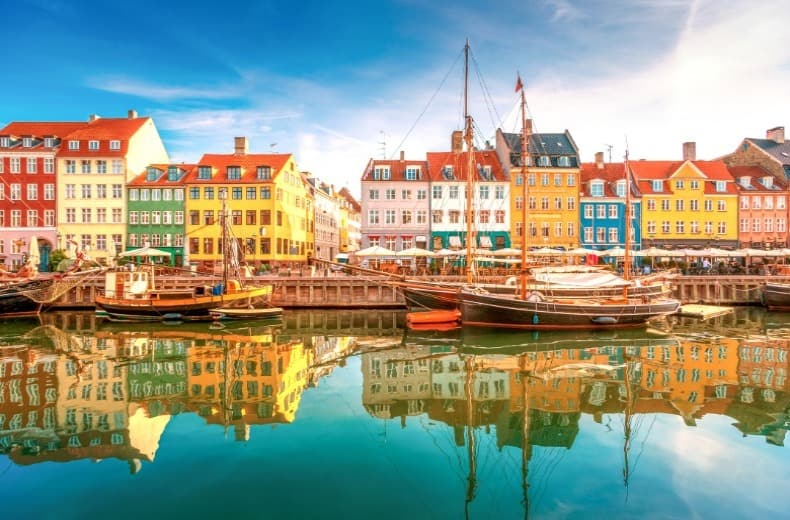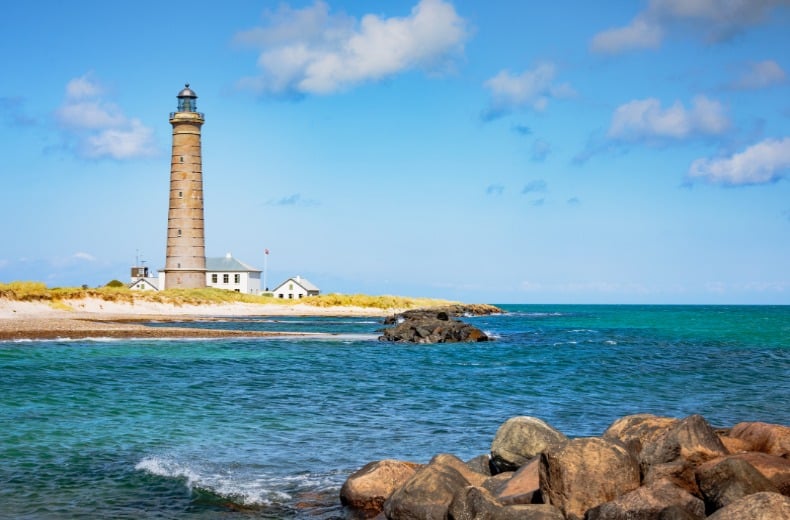Driving advice for every country in Europe
From required documents to European breakdown cover and vehicle accessories, find all the up-to-date driving laws and advice for every country in Europe in our travel guides.
Driving in Denmark

But if you’re planning a road trip to Denmark, it’s essential you’re fully prepared ahead of time as driving there has many differences to the UK.
To make your journey to Scandinavia as safe and effortless as possible, we’ve put together a guide to everything you need to know before you go, from required documents to rules of the road.
Driving a rented vehicle? Jump to the advice for driving a hire car in Denmark section.
RAC European Breakdown Cover provides a wide range of benefits should you break down in Denmark to ensure you stay safe.
To supplement this, RAC also offers travel insurance. Cover will include medical expenses, baggage, personal money and belongings, among many other benefits.
Need short-term insurance for your vehicle? Our temporary car cover is perfect if you're looking for flexible insurance for between 1 hour and 30 days.
Things to take when driving in Denmark

Documents for driving in Denmark
- A valid, full UK driving licence (you must also be 18 or over)
- Your motor insurance certificate
- The V5 registration document for your own car or the hire car paperwork for a rental
Do I need a GB or UK sticker for driving in Denmark?
Since 28th September 2021, the distinguishing mark (or national identifier) displayed on vehicles registered in the United Kingdom that are driven abroad has changed from GB to UK.
This means that vehicles registered in the UK must display the letters “UK” when driven in Denmark.
The identifier can be incorporated in vehicle number plates (along with the Union Flag) or as a separate sticker. Note that vehicles featuring the letters GB together with the Council of Europe golden stars are no longer valid for driving abroad.
If your vehicle does not have the UK identifier within the number plate, you will require a UK sticker when driving in Denmark. GB stickers will no longer be valid from the end of September.
Do I need an insurance green card?
From 2nd August 2021, drivers no longer require an insurance green card for taking their vehicles to Denmark.
ETIAS – 2026
ETIAS stands for the European Travel Information and Authorisation System. It is a visa program for visitors who don’t need a Schengen visa, who want to travel to the European Union and a few other European countries.
Visitors who purchase an ETIAS will be able to enter the 26 member states of the Schengen Zone as well as Bulgaria, Croatia, Cyprus, and Romania.
This will be launching in 2026. Learn more about ETIAS here.

Instant cover available
• 24/7 rescue at the roadside
• Help to get home if your vehicle can't be fixed
• 5 star Defaqto rated cover

Driving in Denmark packing checklist
Aside from the documents above, there are some legally-required items you must bring with you to drive in Denmark.
Unless your headlights can be adjusted, it's a legal requirement to carry headlamp converters (stickers for your headlights when driving on the right, so your lights don't dazzle motorists coming the other way).
A warning triangle is also compulsory to carry in vehicles in case of a breakdown.
It's also recommended to have:
- Spare bulbs for your car's external lights
- A fire extinguisher
- A first-aid kit
- A reflective jacket
You can pick up all the car kit you need from RAC Shop.
Is there anything that I shouldn’t take with me?
Be aware that you cannot take the following with you into Denmark:
- meat or products containing meat
- milk or dairy products
You cannot take the following unless you pay to have them inspected before you leave and get a ‘phytosanitary certificate’:
- fresh fruit (apart from bananas, coconuts, dates, pineapples and durians)
- vegetables
- plants
- plant products
Rules of the road in Denmark
Danish driving doesn't differ too much from what we're used to in the UK (aside from driving on the right), but here are some general tips to make sure you're prepared.
- In Denmark, you drive on the right and overtake on the left. Vehicles from the right generally have priority
- Low-toned horns should only be used when an audible warning is required to prevent an accident
- Use dipped headlights during the daytime all year round and on all roads
- Make sure everyone in the car wears a seat belt at all times
- Wear a crash helmet if you're riding a motorcycle or moped
- Ensure your car is covered by third-party insurance recognised in Denmark. This is the legal minimum cover for visitors, so check with your provider before you travel
- Children over three years and under 135cm in height must use an appropriate restraint or child seat. Children under three years of age must be placed in an approved restraint system adapted to their size
- The drink-drive limit for all drivers is 0.05%. Random tests are carried out by police officers, even if there are no grounds for suspicion
- If you're caught committing a minor driving offence while travelling through Denmark, you could be given an on-the-spot fine
Danish speed limits
In most built-up areas, the speed limit is set at 50km/h unless otherwise signed. Outside these areas, the limit is 80km/h.
On motorways, the limit varies from 110km/h to 130km/h, so check signs locally to stay within the legal limit.
Other things you should know when driving in Denmark

- There are no emergency phones located on the motorways
- Denmark does not have motorway tolls, but there are some bridges where a charge is levied, including the Oresund bridge linking the country with Sweden
- Petrol stations and service areas are available in large towns and cities and at 50km intervals on motorways in Denmark
- Unleaded petrol and diesel are readily available throughout Denmark. Many petrol stations have automatic pumps that accept international credit cards
- Parking can be limited in built-up areas, especially in and around Copenhagen, with restricted zones signposted. Wheel clamps are not used in Denmark, but wrongly parked vehicles may be towed away
In an emergency
112 - Here's a really important bit of knowledge; you can dial 112 from anywhere in Europe and an operator will connect you to an emergency service in the country you're visiting.
Operators can answer your call in their native language, English or French.
Breaking down in Denmark
RAC offers great-value, flexible RAC European breakdown cover tailored to meet your needs. We also offer comprehensive travel insurance, including cover for medical expenses, baggage, personal money and belongings.
Driving a hire car in Denmark
Not all of the information in the guide above will be relevant to those looking to rent a hire car in Denmark.
Though it might be a good idea to read through everything anyway, here are the most important things to know for drivers of rental vehicles:
Rental information
- The minimum age to hire a car is 21
- You need a full, valid UK driving licence and usually a second proof of ID (passport)
- Some car rental companies ask that you have held your licence for a minimum term - check with your hire company first
- Most companies require you to use a credit card for deposit
- You may not be able to drive outside of Denmark unless planned in advance - check with your hire company first
- Make sure you get car hire excess insurance before your trip to protect yourself from unexpected costs. It's almost always cheaper to do this with a separate insurer and in advance
Hire car driving tips
- Danes drive on the right and overtake on the left - the opposite to the UK
- The national speed limit on Danish motorways is between 110km/h (68mph) and 130km/h (80 mph). On a main road outside a built-up area it's 80 km/h. For built-up areas it’s 50km/h
- Dial 112 in an emergency
- It’s compulsory to wear seat belts in the front and rear seats
- The blood alcohol content limit for drivers of private vehicles is 0.05%. That's lower than the 0.08% in England Wales and Northern Ireland, but the same as Scotland.


Driving in Denmark FAQs
- Is it safe to drive in Denmark?
Denmark is a very safe country for motorists and the road system is maintained to a high standard. One thing to note if you’re driving into Copenhagen is the high numbers of cyclists in the capital, so drive carefully and take extra precautions.
As with driving in any foreign country, it’s important to familiarise yourself with driving laws in Denmark to ensure you stay safe on the roads.
- Can you drive in Denmark with a UK licence?
Yes. You can legally drive in Denmark with a full and valid UK driving licence. You don’t need an International Driving Permit, although it could provide extra peace of mind if you have one.
- Do I need a green card to drive in Denmark?
Like the UK, Denmark is a member of the Green Card System, a Europe-wide scheme that allows countries to recognise foreign vehicle insurance policies of visiting motorists.
UK motorists are no longer required to carry a green card to drive in Denmark, but you should check that your policy will cover you in all countries you plan to visit before setting off.
- What side of the road do they drive on in Denmark?
As in most European countries, motorists drive on the right-hand side of the road in Denmark.
- Can I drive my car in Denmark?
Yes, so long as you have all your essential documents, including a valid UK licence, V5 document and sufficient insurance for your trip.
You should also familiarise yourself with the laws around driving in Denmark and ensure you have all the required items needed for your journey (such as a warning triangle and headlamp converters). That applies to any other country you’re planning to drive through, too.
- How do I drive to Denmark?
As there are no longer any direct ferry routes from the UK to Denmark, you’ll have to go either via Calais in France or the Netherlands, via a ferry from Newcastle, Hull, or Harwich.
From Calais drive up to Denmark through Belgium, the Netherlands, and Germany. The drive from Calais to Copenhagen takes around 12 hours non-stop, although there are plenty of great stop-off destinations on the way.
- What age can you start driving in Denmark?
To legally drive in Denmark, you must be 18 years or older and in possession of a full valid driving licence.
- Does Denmark have toll roads?
Denmark does not have motorway tolls, but there are some bridges where a charge is levied, including the Oresund bridge linking the country with Sweden.
- Do you need winter tyres to drive in Denmark?
There is no requirement for winter tyres in Denmark, although studded tyres may be used from 1st November to 15th April.
- When do my lights need to be switched on in Denmark?
Dipped headlights – or special daytime running lights, if your car has them – must be used whatever time of day you’re driving and regardless of whether it’s sunny or not. This is to make sure you’re always visible to other drivers so you stay safe.

Instant cover available
• 24/7 rescue at the roadside
• Help to get home if your vehicle can't be fixed
• 5 star Defaqto rated cover

UK Government travel advice
Fuel
Fuel prices in Denmark can be found in our up-to-date European fuel prices page.
British Embassy in Copenhagen
Kastelsvej 36-40
DK-2100 Copenhagen
Denmark
Telephone: +45 35 44 52 00
